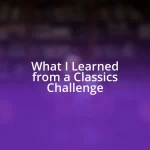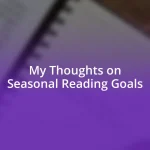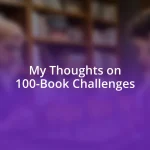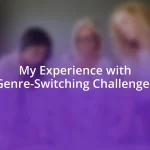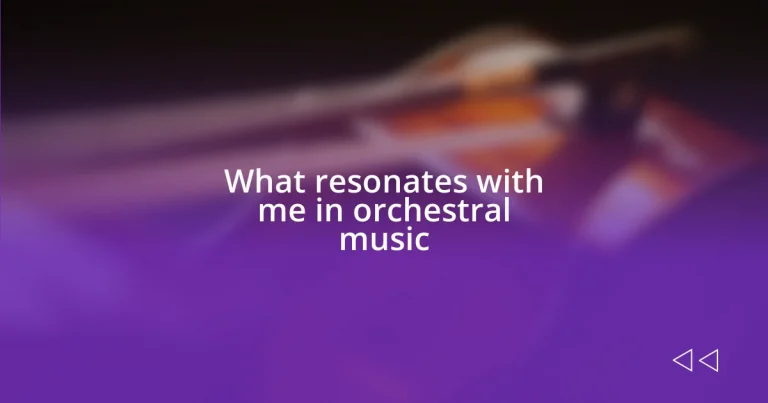Key takeaways:
- Orchestral music evokes deep emotional connections, reflecting personal experiences of joy, sorrow, and introspection through its complex compositions.
- Key elements of orchestral music—instrumentation, harmony, and rhythm—work together to create diverse emotional landscapes, enhancing the listener’s engagement and understanding.
- Active listening techniques, such as reflecting on emotions and taking notes, enrich the experience, while exploring different orchestral genres reveals the evolving nature of music and its profound storytelling ability.
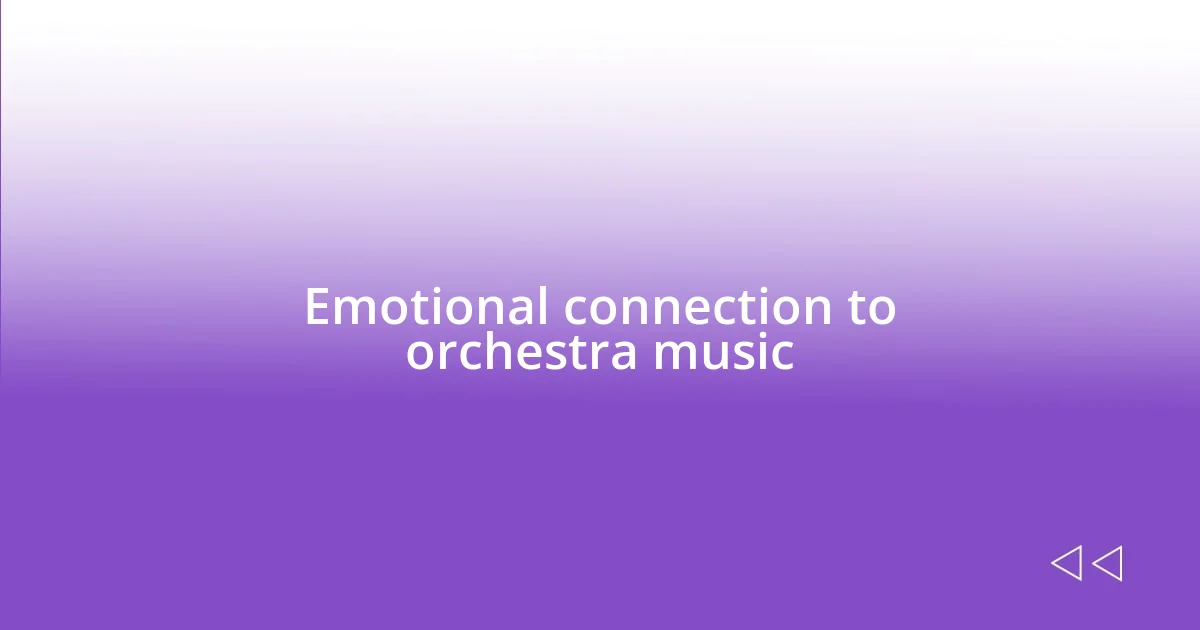
Emotional connection to orchestra music
There’s something uniquely powerful about orchestral music that reaches deep within us. I recall sitting in a grand concert hall, the dim lights casting shadows over the musicians, and feeling chills sweep over me as the violins soared. How can a mere arrangement of notes evoke such profound feelings? It’s in those swellings and cadences that I find a reflection of my own emotions—joy, sorrow, longing—all interwoven in a tapestry of sound.
Every time the orchestra plays a piece full of crescendos and decrescendos, I feel as though my heart is being taken on a rollercoaster ride. When a soft cello solo emerges amidst a robust brass section, it’s like a moment of clarity amidst chaos; I can’t help but wonder, do others feel this magnetic pull too? The many layers of orchestral composition allow me to experience complex emotions that words often fail to encapsulate, connecting me to others and to myself.
Thinking back to moments where I’ve listened to an orchestral score alone in my room, it strikes me how these experiences can feel both intimate and expansive. In those quiet moments, the music transforms my space, wrapping around me like a warm embrace. Do you have a favorite piece that evokes an equally strong personal connection? For me, it’s always a journey, as each note seems to peel back layers of my own heart, allowing for reflection and emotional release.
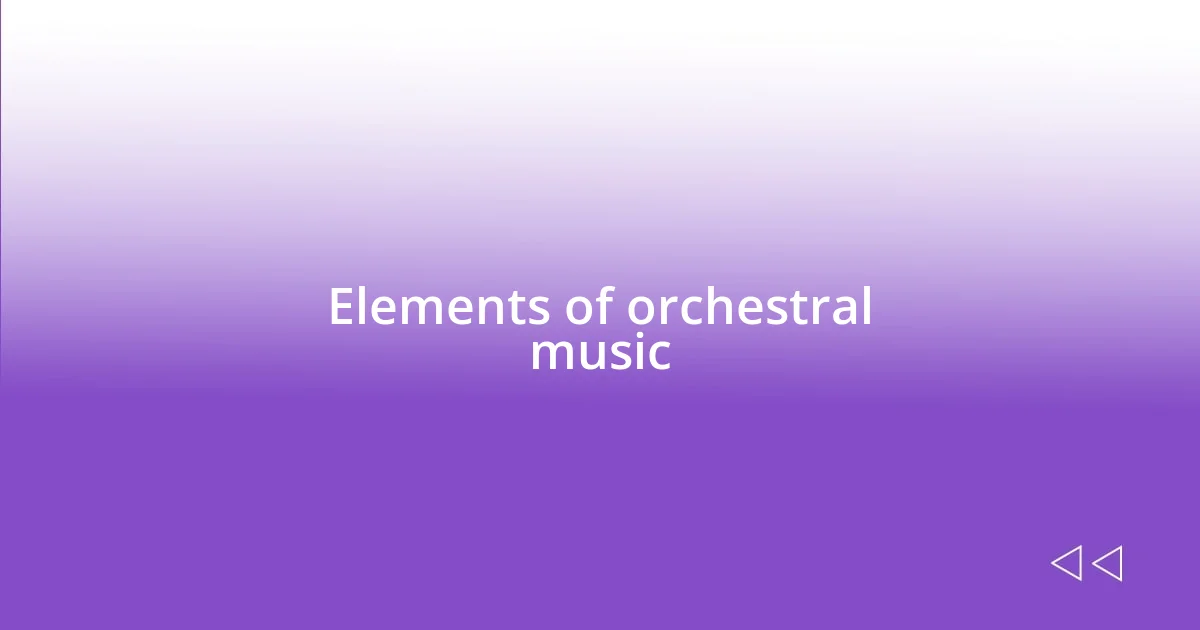
Elements of orchestral music
Orchestral music is a rich tapestry woven from various elements, each contributing to its unique sound and emotional depth. One of the key components is instrumentation. The blend of strings, woodwinds, brass, and percussion creates a diverse sonic palette. I often find myself captivated by how a single flute can shimmer above a full orchestra, piercing through the texture like a ray of sunlight. The way these instruments interact not only produces a distinctive sound but also evokes a myriad of feelings—joy, nostalgia, or even melancholy.
Another crucial element is harmony. The relationships between notes create emotional landscapes that resonate with listeners on a fundamental level. For instance, I vividly remember a breathtaking moment in a symphony where the harmonies shifted unexpectedly. It left me breathless, as if I had been taken on a sudden journey through uncharted emotional territory. Harmonies can stir our innermost feelings, often before we even have the words to articulate them. This complexity makes orchestral music continually fascinating and relatable, revealing new layers with each listening experience.
Then there’s rhythm, which often dictates the emotional pacing of a piece. I’ve found that a sudden shift in tempo can feel like a jolt of energy. For instance, a lively allegro passage can evoke excitement, while a slower adagio can evoke introspection. I can recall listening to a symphony that slowly built up its tempo, and it felt like the orchestra was coaxing me to join in a dance, lifting my spirits with each beat. This rhythmic diversity is crucial in maintaining the listener’s engagement, ensuring that no two experiences with the music are ever the same.
| Element | Description |
|---|---|
| Instrumentation | The combination of various instrument types, creating a unique sonic palette. |
| Harmony | The relationship between notes that creates emotional landscapes. |
| Rhythm | The varying tempo and pace that dictate the flow of the music. |
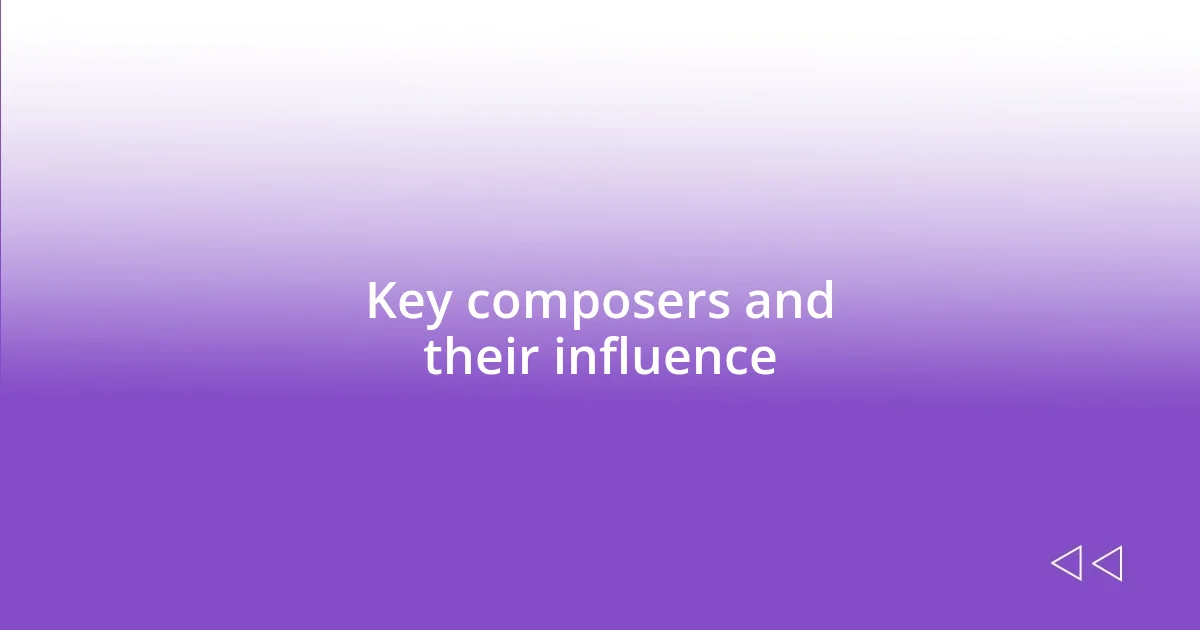
Key composers and their influence
Key composers have profoundly shaped the landscape of orchestral music, each leaving a distinct mark that resonates with me on a personal level. When I listen to Beethoven, I often reflect on his ability to convey deep struggle and triumph. His Ninth Symphony, for instance, feels like a cathartic culmination of human experience; with its jubilant choral finale, I can’t help but feel uplifted and inspired. Similarly, Tchaikovsky’s “1812 Overture” sends shivers down my spine with its commanding contrasts that depict chaos and resolution. His sweeping melodies remind me of the ebb and flow of life’s own tumultuous moments, demonstrating how music can transcend time and touch the heart.
- Ludwig van Beethoven: Revolutionized emotional expression in symphonic writing, deeply influencing romantic composers. His works often mirror my own struggles and triumphs.
- Pyotr Ilyich Tchaikovsky: Known for his passionate melodies that embody human emotion. His vivid orchestration evokes my innermost feelings and reminds me of life’s complexities.
- Johann Sebastian Bach: Pioneered counterpoint and harmony. I feel a sense of tranquility when absorbing his intricate textures, evoking a connection to a more divine order in life.
- Gustav Mahler: His expansive symphonies often take me on emotional journeys that span the spectrum from despair to hope. I find comfort in the way his music embraces both light and darkness.
Through these composers and their innovative approaches, I connect to a rich history of emotion and expression that continues to influence my own understanding of sound and feeling.

Personal reflections on music experiences
There was a night when I sat in a concert hall, and the moment the orchestra began to play a piece by Mahler, I could feel an electric charge in the air. As the music swelled, I was swept into a realm of emotion that seemed to resonate with my own personal struggles. It made me wonder—how can mere notes arranged in a specific order conjure such depth of feeling? For me, that night became a reminder that music has the power to articulate what often remains unspoken within us.
I’ve often found comfort in Bach’s intricate counterpoint, especially during moments of chaos in my life. There’s something profoundly grounding about his music. It’s as if each intertwining line reflects the complexity of our experiences while also providing tranquility. Listening to his compositions often leads me to ponder: isn’t it fascinating how music can mirror the chaos of our existence yet still bring clarity amidst the noise?
One particular memory stands out: attending a Tchaikovsky concert under the stars. As his melodies filled the air, the emotional contrasts between joy and sorrow struck a chord deep within me. I remember feeling invigorated during the jubilant sections while also being drawn into a bittersweet introspection. This glimpse into the duality of his music made me ask myself, do we not all experience life in such a mosaic of triumphs and tribulations? It’s in this blending of emotions that orchestral music becomes a profound companion on our journey.

Techniques for active listening
Being an active listener amidst the rich tapestry of orchestral music can transform your experience. One technique that I find immensely helpful is to close my eyes and focus solely on the different instrument sections as they weave in and out. Have you ever noticed how the strings can evoke a sense of warmth while brass can make your heart race? This method not only hones your attention but also allows you to appreciate the unique voice each instrument contributes to the overall narrative.
Another approach that resonates with me is to take brief pauses between movements to reflect on what I’ve just heard. I often ask myself questions like, “What emotions did this piece stir within me?” or “How do these sounds connect to my own life?” This reflection adds layers to my experience and deepens my understanding of the composer’s intentions. It transforms listening from a passive activity into an engaging dialogue, where music converses with my emotions.
I like to make notes during concerts or while listening at home. Scribbling down thoughts or feelings about particular passages helps me capture the magic in real-time. After each listening session, I review my notes and often discover themes or emotions I initially overlooked. Can you remember a time when a piece spoke to you in a way that lingered long after it ended? Such reflections can reveal personal insights, making active listening not just an auditory experience, but also a profound exploration of self.
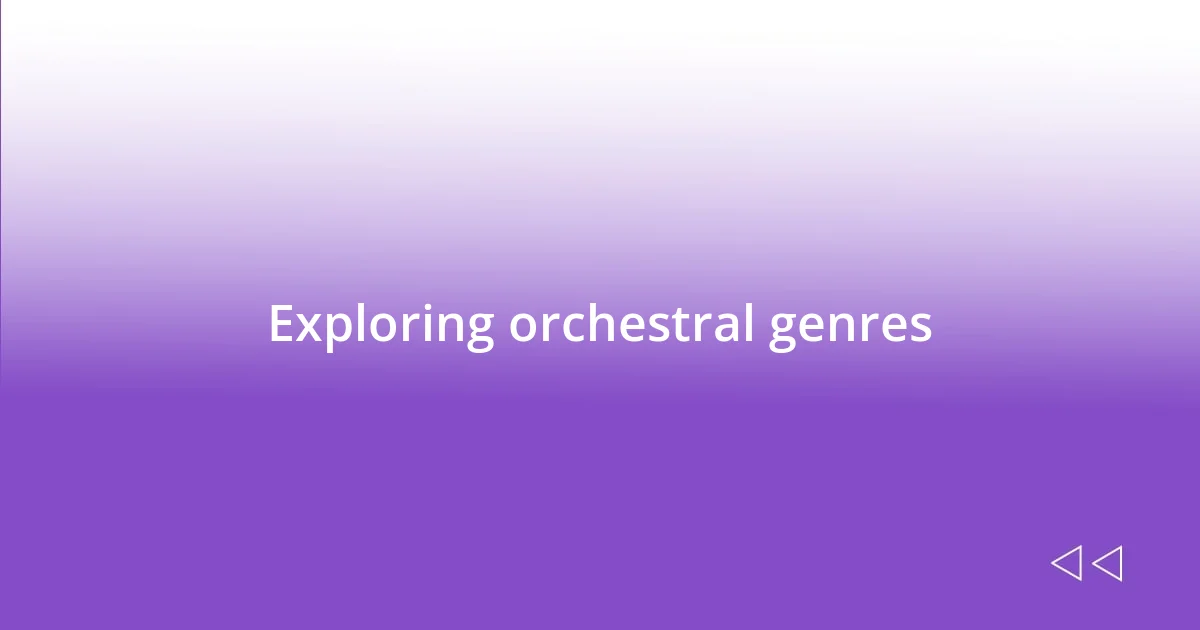
Exploring orchestral genres
Exploring the world of orchestral genres is like taking a delightful journey through emotional landscapes. I remember attending a contemporary concert featuring minimalist composers like Steve Reich. The repetitive motifs and shifting rhythms felt hypnotic, almost like I was in a trance. This genre challenged my expectations and opened my eyes to how music can evolve over time, leading me to ponder: how does innovation in orchestral music reflect our changing world?
I’ve often found that romantic-era composers, such as Brahms, speak to my heart in a unique way. His lush harmonies and sweeping melodies draw me in and create a sense of longing that resonates deeply within me. It’s fascinating how the subtleties in his work can suggest both yearning and satisfaction, making me reflect on the complexity of human emotions. Doesn’t it feel as if these composers were unearthing the rawness of our experiences, layer by layer?
Then there’s the grandeur of film scores, which has completely enchanted me in recent years. Listening to the sweeping themes of composers like John Williams, I feel transported into another realm entirely. I recall watching an outdoor screening of “Star Wars,” where the orchestral music elevated every scene to epic proportions, making me realize how deeply sound can influence our perception of narrative. Have you experienced that moment where music tells a story without a single word? It’s moments like these that reveal the magic orchestral genres embody, allowing us to explore emotions we didn’t even know were there.

Recommendations for orchestral pieces
Here are some thoughtful recommendations for orchestral pieces that resonate deeply with my experience of the genre. One standout work for me is Tchaikovsky’s “Symphony No. 6,” often called the “Pathétique.” Its emotional journey is so vivid; I remember sitting in an intimate concert hall, enveloped in the rich, melancholic melodies. Have you ever felt the weight of nostalgia settle on your heart as the strings swell? I certainly did, and it was a breathtaking reminder of how music can encapsulate the human experience.
Another piece that consistently leaves a mark on me is Debussy’s “La Mer.” The way the orchestra mimics the crashing waves and shifting tides transports me to the coast. I vividly recall being outdoors, listening to it on my headphones as a light breeze blew through my hair, making the sea’s power palpable. Isn’t it fascinating how orchestral music can harness the essence of nature? The layers of sound mimic the ocean’s beauty and chaos seamlessly, echoing emotions that seem to rise and fall like the tide.
Lastly, if you’re open to modern experiences, I would highly recommend exploring the poignant work of Max Richter, particularly “Sleep.” This piece blends classical instrumentation with ambient sounds, creating a tranquil aura that resonates in a unique way. I remember lying on my couch, letting the gentle waves of music wash over me as I drifted somewhere between sleep and wakefulness. Have you ever felt music wrap around you, like a comforting blanket? Richter’s work truly demonstrates how orchestral music can evolve, inviting listeners to engage with it in fresh and contemplative ways.


